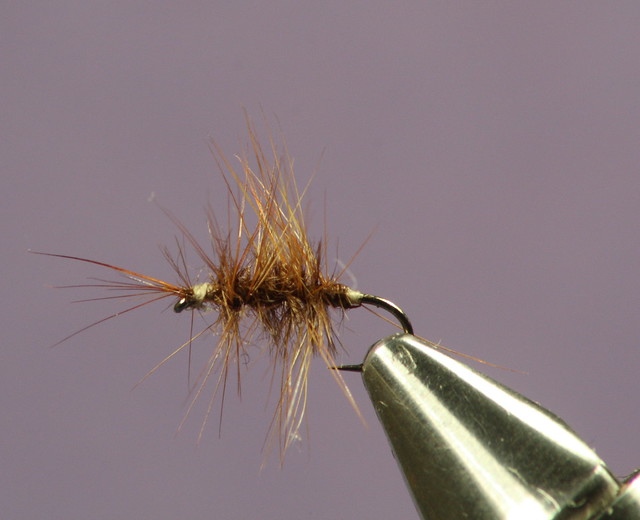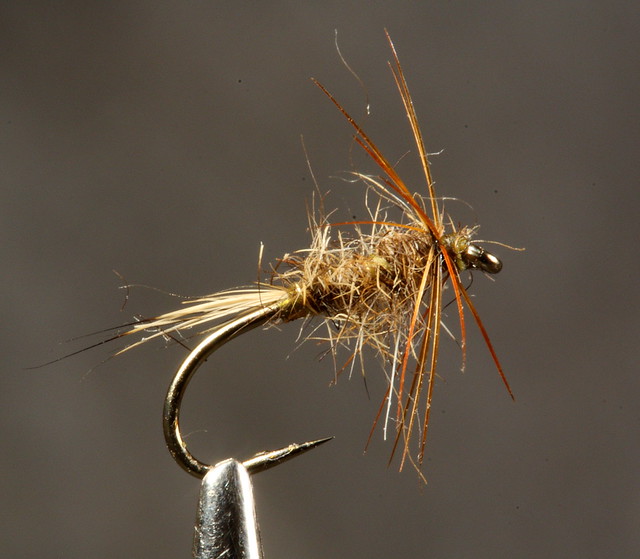Natural by design
Posted: Sat Oct 30, 2010 2:35 pm
Hi,
Been meaning to post this for a while.
There is an ongoing debate, whether soft hackled patterns are suggestive or imitative, and indeed what the difference is! Otter has written eloquently and persuasively in favour of the imitative approach, and it always makes me smile because of my experience tying up a fly to imitate a particular fly on my river.
It was towards the end of last season and i was out of action fishing-wise due a bad neck. However, I still needed my waterside fix, so I found myself spending a lot of time just lurking around the river, watching the insect life and fish activity. The predominant fly on my water at this time (Septemeber) was the willow fly. Now what we call the willow fly in the UK is in fact one of the smaller stoneflies (Plecoptera) and goes under the monika of Leuctra geniculata, for any entomologists out there.
I put this, because I seem to remember in the States the common name willow fly refers to something completely different, and I also seem to remember reading that the willow fly I am referring to is absent from Ireland. Thinking about it, I have just alienated many on this forum! Oh well, I'll press on...
Oh well, I'll press on... 
The thing that most struck me about these small stoneflies, is the clumsiness of their flight. The wing beat is slow enough for the wings to be visible, all be they a blur, and it is as if they actually manage to change direction a few moments after deciding to do it. As such, to my eye, they very much occupy a three dimensional space, sketched out by those wings. And the fish were making an absolute meal of the female flopping around on the surface, depositing her eggs.
Rather pretentiously I sat down at the vise and tried to capture something of that visual 'noise'.
One of the patterns I tied up was this, which imaginatively enough, I called The Willow Fly.

willow by ASGriffiths, on Flickr
#14 light weight hook, tan thread to hook bend, leave some tan wraps exposed for egg sack, tie in couple of strands brown ostrich herl, reddy brown soft feather cock (later genetic hen - easier to get) twist the lot around the thread, wind in open turns back to eye, trap down a few barbs over the eye for antenae, and go fish.
Fished upstream, just the slightest touch of gink on the barbs above the hook shank, applied almost superstitiously, and fish dead drift. It was lethal! It was just about the only fly I needed for a month and it took grayling after grayling. I passed it around, and it was working well for others too - much to their amazement when they had looked at it in with some distaste before they fished it!
It was just about the only fly I needed for a month and it took grayling after grayling. I passed it around, and it was working well for others too - much to their amazement when they had looked at it in with some distaste before they fished it! 
This was the first ever fly I had tied as a result of studying the natural. To say that I was chuffed would be an understatement. In fact, the next time I stepped into the river, I was surprised my wading boot actually managed to penetrate the water.
Now fast forward a few months, to the beginning of this season, think it was early April. I put a couple of flies over an intermittently rising fish, sitting just on the edge of a fast chanel of flow, over time busy cutting out the river bend. Dark Olives on the water. Unusually, no joy with my usual suspect, but there in my box was one of these willow flies from the season before.
Tied it on, the trout took it first pass, a fish just north of a pound, which proved to be my best of the season from this small stream. And not a willow fly in sight.
My point is, that if you had asked me last year, I would have whole-heartedly agreed with Otter's imitative reasoning, but it is my experience with this fly that has tipped me further over into the suggestive camp.
This is why I believe that much is in the angler's mind, our own perception rather than that of the fish. I looked at that fly and saw a willow fly. I thought the trout and grayling at the end of last season did too. But what did that trout see early this season? Certainly not a willow fly. Presumably, it was enough like a dark olive in the speed of the flow for it take it. And maybe the reality was, at the end of last season, it was just enough like a willow fly for those fish to take it too.
This debate, between imitative and suggestive, can easily become one of semantics - do we all actually mean the same thing when we use the same term? On that note, I would like to enter a third term, that for me more accurately represents what I think at the moment is going on with spiders - I think they are impressionistic.

Andrew.
ps - as an aside, I subsequently discovered that the pattern I had 'invented' , palmered soft hackle over ostrich herl, was first mentioned by Charles Cotton! (1630 - 1687). So, slightly pipped to the post there then...
Been meaning to post this for a while.
There is an ongoing debate, whether soft hackled patterns are suggestive or imitative, and indeed what the difference is! Otter has written eloquently and persuasively in favour of the imitative approach, and it always makes me smile because of my experience tying up a fly to imitate a particular fly on my river.
It was towards the end of last season and i was out of action fishing-wise due a bad neck. However, I still needed my waterside fix, so I found myself spending a lot of time just lurking around the river, watching the insect life and fish activity. The predominant fly on my water at this time (Septemeber) was the willow fly. Now what we call the willow fly in the UK is in fact one of the smaller stoneflies (Plecoptera) and goes under the monika of Leuctra geniculata, for any entomologists out there.
I put this, because I seem to remember in the States the common name willow fly refers to something completely different, and I also seem to remember reading that the willow fly I am referring to is absent from Ireland. Thinking about it, I have just alienated many on this forum!
The thing that most struck me about these small stoneflies, is the clumsiness of their flight. The wing beat is slow enough for the wings to be visible, all be they a blur, and it is as if they actually manage to change direction a few moments after deciding to do it. As such, to my eye, they very much occupy a three dimensional space, sketched out by those wings. And the fish were making an absolute meal of the female flopping around on the surface, depositing her eggs.
Rather pretentiously I sat down at the vise and tried to capture something of that visual 'noise'.
One of the patterns I tied up was this, which imaginatively enough, I called The Willow Fly.

willow by ASGriffiths, on Flickr
#14 light weight hook, tan thread to hook bend, leave some tan wraps exposed for egg sack, tie in couple of strands brown ostrich herl, reddy brown soft feather cock (later genetic hen - easier to get) twist the lot around the thread, wind in open turns back to eye, trap down a few barbs over the eye for antenae, and go fish.
Fished upstream, just the slightest touch of gink on the barbs above the hook shank, applied almost superstitiously, and fish dead drift. It was lethal!
This was the first ever fly I had tied as a result of studying the natural. To say that I was chuffed would be an understatement. In fact, the next time I stepped into the river, I was surprised my wading boot actually managed to penetrate the water.
Now fast forward a few months, to the beginning of this season, think it was early April. I put a couple of flies over an intermittently rising fish, sitting just on the edge of a fast chanel of flow, over time busy cutting out the river bend. Dark Olives on the water. Unusually, no joy with my usual suspect, but there in my box was one of these willow flies from the season before.
Tied it on, the trout took it first pass, a fish just north of a pound, which proved to be my best of the season from this small stream. And not a willow fly in sight.
My point is, that if you had asked me last year, I would have whole-heartedly agreed with Otter's imitative reasoning, but it is my experience with this fly that has tipped me further over into the suggestive camp.
This is why I believe that much is in the angler's mind, our own perception rather than that of the fish. I looked at that fly and saw a willow fly. I thought the trout and grayling at the end of last season did too. But what did that trout see early this season? Certainly not a willow fly. Presumably, it was enough like a dark olive in the speed of the flow for it take it. And maybe the reality was, at the end of last season, it was just enough like a willow fly for those fish to take it too.
This debate, between imitative and suggestive, can easily become one of semantics - do we all actually mean the same thing when we use the same term? On that note, I would like to enter a third term, that for me more accurately represents what I think at the moment is going on with spiders - I think they are impressionistic.
Andrew.
ps - as an aside, I subsequently discovered that the pattern I had 'invented' , palmered soft hackle over ostrich herl, was first mentioned by Charles Cotton! (1630 - 1687). So, slightly pipped to the post there then...
